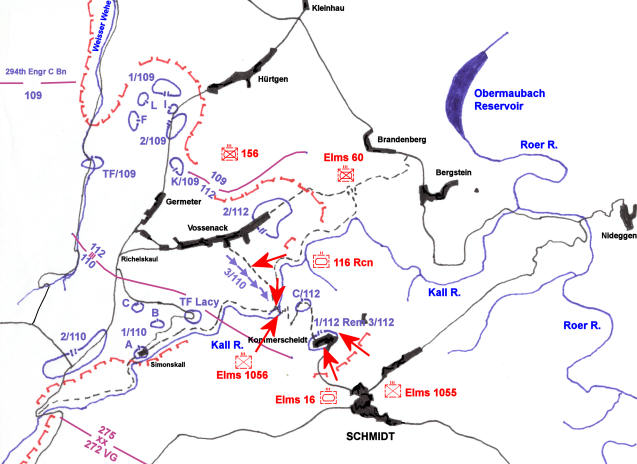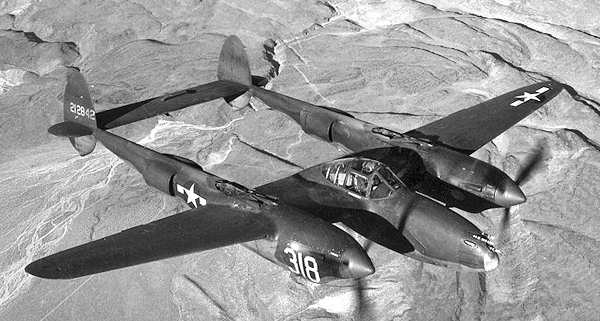in the Hurtgen Forest
Germany, 2 - 14 November 1944
(Rhineland Campaign)
ORGANIZATION OF TASK FORCE RIPPLE
By Major Paul A. Troup, Jr.
Late in the afternoon of the 5th of November, General Cota, Commanding General of the 28th Infantry Division, ordered that Task Force Ripple be organized and given the mission of attacking through the 112th Infantry and retaking Schmidt on the 6th of November. Upon the recapture of Schmidt the task force would set up road blocks and prepare to hold the town until the 112th could relieve them. The task force upon relief would then prepare to attack in the direction of Steckenborn. Task Force Ripple was composed of the 3rd Battalion of the 110th Infantry (approximately 350 men), Companies "A" and "C" with one platoon of Company "B" of the 707th Tank Battalion, and a detachment of the 893rd Tank-Destroyer Battalion. 35
The 2nd Battalion in Vossenack shook off two enemy counterattacks as it was slowly being gnawed away by artillery fire. 36
The forward echelon of the Regimental Command Post was "dug in" about 800 yards northwest of Kommerscheidt, in the area of Company "C" which was in 1st Battalion reserve. 37
The 109th and 110th Infantries made bitterly contested gains in their sectors. The 110th Infantry was involved in the arduous task of reducing the forest fortifications. 38
The fighter-bombers of the 9th AAF straffed and bombed Schmidt where the enemy appeared to be assembling for a major attack on Kommerscheidt. 39
On 6 November 1944 at 0200 hours Task Force Ripple moved from its assembly area toward the Vossenack - Kommerscheidt trail; keeping in the edge of the woods so as to avoid the artillery fire that was falling in Vossenack. Lt. Col. Ripple planned to use the present front line of the company in position just west of Kommerscheidt as the line of departure for the attack on Schmidt. As the task force attempted to cross the stone bridge over the Kall River, it was fired upon by infiltrated enemy and therefore had to fight its way to the positions of the 1st and 3rd Battalions. The armored elements of the task force remained in the vicinity of Vossenack until the trail could be cleared. Prior to the arrival of the task force the 1st and 3rd Battalions began to receive very heavy artillery fire that was coupled with fire from self-propelled guns and small arms on their positions. It was evident that the enemy was waiting for the task force to attack because it appeared that every gun had re-zeroed in on Kommerscheidt and every observer had his attention focused on the area and fired at anything that moved to the front of the town. The impracticability of the attack of the task force was soon realized and was called off. The task force moved into and prepared a defensive position to the right of Company "C". 40

6 November
The "Shell Happy" 2nd Battalion in Vossenack was attacked twice but both assaults were beaten off; however, the increased volume of direct fire from self-propelled guns added to the ever increasing pressure of the infantry attacks forced the battalion to withdraw to the church in the center of the town. Here the battalion was reorganized and was reinforced as follows: 146th Engineer (C) Battalion in the town, 20th and 1340th Engineer (C) Battalions on a line south of the town extending to the east side of the stone bridge across the Kall River, and that put the 2nd Battalion in positions along the north edge of the town. The 20th Engineer (C) Battalion had the mission of trying to keep the trail across the Kall open as it was the only line of communications between the troops in Kommerscheidt and those in Vossenack. Counterattacks continued but the positions as they were reenforced held. 41
The situation in the 112th sector was critical. The ever increasing fury of the enemy attacks was taking a heavy toll on men and material. The armor of the 707th Tank Battalion and the 893 Tank-Destroyer Battalion was slowly being made ineffective due to the concentrated fire placed on them in the exposed positions they were forced to utilize. The road between Vossenack and Kommerscheidt which was inadequate at the start of the attack became an obstacle when it became soaked by the rain and snow of the prevailing bad weather. The other roads were so deep in mud that traffic had to be kept to an absolute minimum. The physical and mental condition of the men on position was anything but desirable. They were just existing; they were cold, soaked to the skin by the rain and clinging wet snow, and miserable. The constant threat of counterattack and the methodically pounding of the position by an ever increasing volume of massed enemy artillery fire made sleep scarce and casualties high. Replacements joined the fight and were evacuated before the squad leaders got to know their first names. 42
During the day a self-propelled gun that was located some where near Brandenberg had laterally bracketed the shallow, dug out that served as the forward Regimental Command Post and had had one round short when a P - 38 loaded with a "Blaze Bomb" dive-bombed the enemy position and silenced the gun. Many drawn and weary faces who had heard the aircraft go into its dive and had watched the effect of the bomb, took another glance at the plane and mutely blessed and thanked this unknown pilot for taking a thorn out of their backs.

P-38 "Lightning"
The P - 47's bombed and straffed Schmidt in an effort to disrupt the assembly of troops that were preparing for the attack on Kommerscheidt. 43

Republic P-47N "Thunderbolt"
In the north the 109th Infantry made little progress in its attack; meeting the usual murderous curtain of fire that the enemy laid down in front of their barbed wire and minefields. 44
At 1500 hours the 12th Regimental Combat Team of the 4th Infantry Division was attached to the 28th Division and plans were made for the relief of the 109th Infantry on the 7 November 1944. 45
The records show that V Corps' artillery had fired 15,000 rounds and that the Tank-Destroyers had fired 1650 rounds or the equivalent of over 10 rounds per minute for this 24 hour period. 46
The 7th of November was initiated at 0800 hours by the 146th Engineer (C) Battalion attacking toward the east end of Vossenack in an effort to regain the ground that had been lost the day before. The attack was supported by tanks and artillery and as was the usual case in this German artillery impact area, the enemy laid a blanket of shells on the attackers. The attack was successful and most of the ground was regained. 47
The 2nd Battalion of the 109th Infantry was ordered to relieve the 2nd Battalion of the 112th Infantry in Vossenack which it completed by 2040 hours. The badly mauled 2nd Battalion retired to an assembly area west of Germeter where it was to be rehabilitated. 48
The morning of the 7th of November also brought the much anticipated attack on Kommerscheidt. Although the first attempt to seize the town was heavily supported by tanks and artillery fire it failed to accomplish its mission. It was a different ending when the enemy attacked at 1430 behind a heavy curtain of artillery fire and supported by 15 to 20 tanks; the fight that ensued was bitterly fought but the overwhelming odds could not be surmounted. The fragments of the two battalions withdrew after their positions became untenable to the line held by Company "C" and Task Force Ripple. 49
Major Hazlett who had commanded the combined 1st and 3rd Battalions in Kommerscheidt and most of his staff were listed among the missing. Included in this list were Captain Martin, Captain Driscoll (Artillery Officer), M/Sgt McCann, and many other seasoned veterans. Lt. Col. Peterson in a personal letter written after the war stated: "The only thing that held us in Kommerscheidt as long as we remained was Major Hazletts courage and the superior cooperation from two artillery Captains (who were both killed by point blank 38mm fire in Kommerscheidt). The tanks and infantry were held back by the artillery fire directed by those two great artillery officers. They called for so many concentrations that I believe that those in the rear figured they were going crazy and towards the end (before the artillery radio was destroyed) the artillery battalions were unable to give the support the observers requested. Apparently we failed to consider that other units on the front needed support." 50
Prior to the loss of Kommerscheidt the division issued orders to form another task force with Brigadier General Davis, Assistant Division Commander, in command. This task force would incorporate Task Force Ripple and would have the mission of recapturing Schmidt. Before Task Force Davis could be fully organized the Corps Commander ordered that due to the precarious position of the troops on the south side of the Kall River, they would be withdrawn. Task Force Davis was given the mission of protecting the withdrawal of these troops on the night of 8 - 9 November 1944. 51
The tank-destroyers were credited with 5 enemy tanks knocked out but of the armor that had traversed the Kall Valley only one tank and two tank-destroyers remained operational. 0ne of the tank-destroyers was lost when a mortar shell hit inside the open turret. 52
The aid station which had been operating in the Kall Valley was captured by German patrols once a day for the past two days. Captain Madden, the Regimental Chaplain, who could speak excellent German and who was present said that the patrol leader would search the aid station for weapons; then ask him if they had enough food and medical supplies. After being informed that the aid station was well supplied, the satisfied patrol leader would move his patrol down the valley and continue on his mission. Captain Madden said that within an hour an American patrol usually consisting of engineers would approach from the same direction and continue the way of the German patrol. 53
During the afternoon of the 7th of November a coded message was received at the forward command post of the 112th Infantry which ordered Lt. Col. Peterson to report to the division command post. The Regimental Commander although reluctant left the position with two men and a jeep and started down the trail that led to Vossenack but at the bottom of the draw the party was ambushed. Col. Peterson and Pfc Seiler were able to get away only to be cut down a few seconds later. Col. Peterson was seriously wounded but after being left for dead he managed to drag himself out of the draw where he was picked up and carried back to the Division Command Post. Here he learned that the message he had received was not sent by the Division Commander. Who sent that message is still one of the unsolved mysteries of the war. 54
On the other sections of the front the units continued to make small gains against a much determined enemy. The 110th Infantry was occupied in cleaning out the pockets of resistance that it had created by its flanking maneuver. 55

